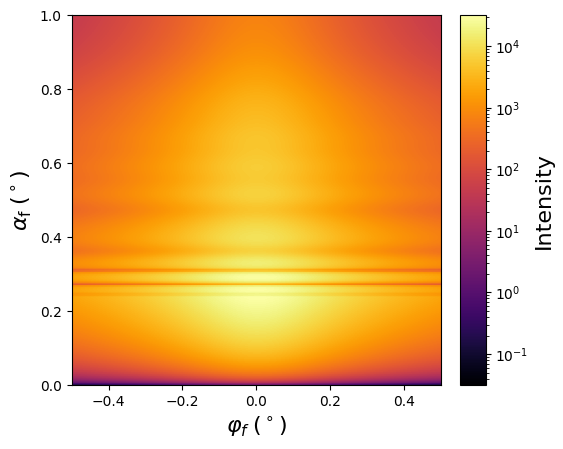1
2
3
4
5
6
7
8
9
10
11
12
13
14
15
16
17
18
19
20
21
22
23
24
25
26
27
28
29
30
31
32
33
34
35
36
37
38
39
40
41
42
43
44
45
46
47
48
49
50
51
52
53
54
55
56
57
58
59
60
|
#!/usr/bin/env python3
"""
MultiLayer with correlated roughness
"""
import bornagain as ba
from bornagain import ba_plot as bp, deg, nm
def get_sample():
"""
A sample with two layers on a substrate, with correlated roughnesses.
"""
# defining materials
vacuum = ba.RefractiveMaterial("ambience", 0, 0)
material_part_a = ba.RefractiveMaterial("PartA", 5e-6, 0)
material_part_b = ba.RefractiveMaterial("PartB", 10e-6, 0)
material_substrate = ba.RefractiveMaterial("substrate", 15e-6, 0)
# defining roughenss
sigma, hurst, corrLength = 1*nm, 0.3, 5*nm
autocorr = ba.K_CorrelationModel(sigma, hurst, corrLength)
interlayer = ba.TanhInterlayer()
crosscorrelation = ba.CommonDepthCrosscorrelation(10*nm)
roughness = ba.LayerRoughness(autocorr, interlayer, crosscorrelation)
# defining layers
l_ambience = ba.Layer(vacuum)
l_part_a = ba.Layer(material_part_a, 2.5*nm, roughness)
l_part_b = ba.Layer(material_part_b, 5*nm, roughness)
l_substrate = ba.Layer(material_substrate, roughness)
# defining periodic stack
n_repetitions = 5
stack = ba.LayerStack(n_repetitions)
stack.addLayer(l_part_a)
stack.addLayer(l_part_b)
# defining sample
my_sample = ba.Sample()
my_sample.addLayer(l_ambience)
my_sample.addStack(stack)
my_sample.addLayer(l_substrate)
return my_sample
def get_simulation(sample):
beam = ba.Beam(5e11, 0.1*nm, 0.2*deg)
n = 200
detector = ba.SphericalDetector(n, -0.5*deg, 0.5*deg, n, 0., 1*deg)
simulation = ba.ScatteringSimulation(beam, sample, detector)
return simulation
if __name__ == '__main__':
sample = get_sample()
simulation = get_simulation(sample)
result = simulation.simulate()
bp.plot_simulation_result(result)
bp.plt.show()
|
